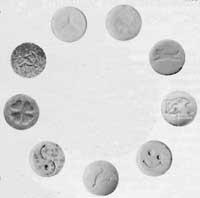“Ventajes” of Ecstasy
Pills called estasi usually have some recorded figure and depending on the image the effect is different. If they have the dove, the woman or the apple engraved, they belong to the love group and exert an empathic influence on the receiver, that is, they facilitate the awareness of what another person feels. Those who have diamond, bull or indian head marked have many more stimulants, such as pseudoephedrine or amphetamine sulfate.

Ecstasy for its relatively cheap form and price (2,000 pts. or worth about 80 pounds), it seems to be just a common medicine. The person taking the pill feels that the interior environment rises to twenty minutes and then feels euphoria and empathy with the person around it for about eight hours.
Let's see what has happened in the recipient's brain to have that influence. Ecstasy is the amphetamine derivative called MDMA (3.4 methylenodioxymethamphetamine). It hinders the normal functioning of brain neurons. Neurons use serotonin (or 5 hydroxytryptamine) as a neurotransmitter. The role of serotonin is complex because in addition to regulating our “mood”, it also influences the body’s thermoregulation, sleep and hunger.
When the situation is normal, the brain controls very well the number of serotonins transmitted through neuronal synapses. The neurotransmitter released by a neuron is fixed on the receptors of another neuron and the excess serotonin is absorbed by the original cell. But when MDMA enters the brain, serotonin is released much and quickly into synapses and the original cell does not absorb excess. Consequently, synapses are impregnated with serotonin and drugged in “ecstasy”.

For twenty minutes serotonin is released and released, and the cells you will take do not absorb serotonin by obstruction of MDMA. When a few hours pass, however, the “ecstasy” of the drug goes away because neurons run out of serotonin.
Although it is not clear how the mechanism works, another neurotransmitter called dopamine begins in the MDMA problem. This hides the feeling of pain and fatigue. That's why, although the one who is dancing has a squat in the leg muscle, he doesn't feel tired of dancing in hours.
Damage caused
Body temperature also increases due to the absence of thermoregulation due to excess serotonin. Sometimes body temperature rises to 43 degrees and the consequence is dehydration. However, the drug dancer should not drink too much water because ecstasy affects the hormonal system that controls urine production. If we drink more than two or three liters of water, the water accumulates in the cells and these can explode causing serious brain damage.
Ecstasy can also cause brain damage (brain injury and paralysis) due to the extent of blood vessels. The liver may also fail because enzymes work too hard to degrade ecstasy. In the heart increases blood pressure and also rhythm, being able to reach dangerous levels. The stomach does not feel hungry, but nausea is frequent and even frequent vomiting.

In the United States, at John-Hopkins University in Baltimore, Paul Ricaurte has researched with rats and apes. Seratonin-soaked nerve cells degenerate over the long term and damage to monkeys seems irreparable. Toxic effects in situations of excess MDMA have also been studied due to increased body temperature and dehydration.
In London, Joe Black and his team, analyzing the cefaraquídeo fluid, have discovered that the amount of 5-HIAA serotonin metabolites decreases considerably. They are normally detected when nerve cells are attacked with serotonin.
History of Ecstasy
Amphetamine MDMA was first synthesized in Germany in 1914. It was then used to eliminate hunger, but those who took it felt “strange effects” and removed it from the market.
After many years of abandonment, he was resurrected in the 1960s. In the army the soldiers began to look for “amines” to be alert for a long time. Biochemist Alexander Shulgin, invented at that time more than 200 drugs, synthesized the molecule, tested and published research results.
The fame of this drug came to psychologists and were soon used in the MDMA psychotherapy offices. He had to help patients talk. This amphetamine soon spread to university campuses and clubs in the area. In 1985 the U.S. organization Food and Drug Administration banned it and then adopted the name “ecstasy.” He arrived in Europe from New York and Chicago in the United States and repeated himself with British tourists in the Ibiza of the Balearic Islands.

However, current ecstasy has nothing to do with initials. It is a drug in constant mutation to flee the law they prohibit. It belongs to design drugs and today, for example, the “green ecstasy” is fashionable. After many months selling, they have recently released the law to ban this drug. When the new design drug is removed, it is taken by the police, checked in the laboratory and finally banned, removed from the market and removed another. Ecstasy is easily synthesized, but it has fewer and fewer MDMA. They are replaced by other similar products: DA (3.4 methylenodioxyamphetamine or amorous drug), MDEA (3.4 methylenodioxylefetamine or Eba), 2-CB (phenylethylamines or Nexus) and amphetamines.
Another problem is the amount of substances present in the pills. The amount of MDMA can range from 9 to 117 milligrams per pill, from 17 to 128 milligrams of mineral, from 8 to 46 milligrams of amphetamine, etc. Drug manufacturing design is a great business for some chemists. In addition, hidden labs are located near consumer centers to reduce the risk of traffic violations.
And in our case what?
The Basque Country, of course, has not been left out of this trend. In our case, more and more synthetic drugs similar to ecstasy are being used. However, they are relatively new to the market, so it is difficult to analyze the trend of their consumption. In fact, the data collected by different organizations is relatively new and a survey can hardly be found that can give a perspective of more than five years.
In the report entitled “Drugs in the Basque Country 1996” that is about to publish the Secretariat for Drug Dependencies of the Basque Government, we have found the only data that offer a vision of all kinds, and therefore we have used as the main basis to analyze the following data and consumption trends.
We have not been able to access the data of Iparralde, so the trends in this article are not reflected. Also, in relation to the consumption data of Navarre, the next renewal of studies on drug addiction is expected, since the latest data on the customs of Navarre were collected at the beginning of this decade, so they do not accurately collect the consumption of these drugs that have just entered the market.
According to data collected in the Basque Government survey, potential users of synthetic drugs are mainly young. Ecstasy is consumed as much as cocaine and acid. Although ecstasy consumption has increased since 1994, it is still not widespread among us: In E.A.E. about 8,500 people have acknowledged having ever used new designer drugs.
Last year's data can give more light on this topic. Two out of every hundred citizens acknowledge having used ecstasy once, but most claim to have tried or received it once. Consumption is therefore very occasional today.
The use of these drugs has increased among young people aged 21 to 25. In this age group, 4% of youth claim to have used it today and 10% said so in their day. Currently, 2% of ecstasy users recognize using it one, two or more times a month.
Among those aged 26 to 30 years, the use of designer drugs has not been detected, while among those aged 31 to 40 years, consumption is relatively low, around 0.1%.
As for sex, men show a greater propensity to chemical drugs of design. However, the increase in consumption that has been observed since 1994 has been identical in both sexes.
Finally, if territorial distribution is analyzed, Gipuzkoa is the country with the highest rate of ecstasy consumption.
Women's sex. Álava Bizkaia Gipuzkoa Current consumers Past consumers - 0,80,8 4,20,5 1,20,3 2,50,6 2,9TOTAL 679679406476476Current Consumers Past Consumers
0.2 0,80,8 4,2total 679679Never Try Alone Rare Assiduously Everyday
99.5 – 0.2 0.3 – – 98.1 1.2 0.4 0.3 – –TOTAL679679Current Consumers Past Consumers
- 2,83,7 10,3- -0,2 2,2- -- -- -Total145150123250229188273Current consumers Current consumers
0.3 0,60,7 3,00,2 0,70,4 1,90,6 2,3 Total 679679406476476




